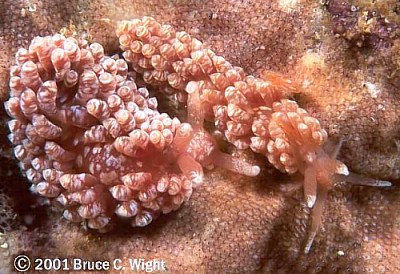
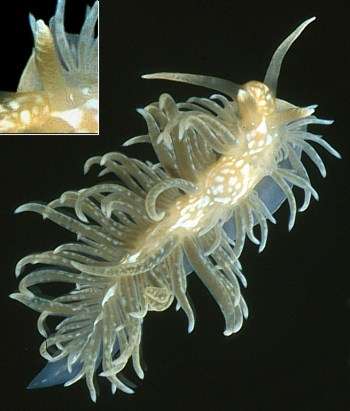
Spurilla chromosoma
Cockerell in Cockerell & Eliot, 1905
Order: NUDIBRANCHIA
Suborder: AEOLIDINA
Family: Aeolidiidae
DISTRIBUTION
Southern California and Mexico. See reports below, apparently of this species, from Japan, and Ecuador.
PHOTO
UPPER: Under rock at San Clemente island, California. PHOTO: Bruce Wight.
LOWERT: Intertidal of Kominato coast, Boso Peninsula, Japan. Body length 25 mm. October 28, 1996.
PHOTO: Yoshi J. Hirano.
Feeds on sea anemone Metridium senile. grows to about 20mm.
Reference:
• Cockerell, T.D.A in Cockerell, T.D.A & Eliot, C. (1905). Notes on a collection of Californian nudibranches. Journal of Malacology, 12(3): 31-53, pls. 7, 8
Rudman, W.B., 2000 (March 18) Spurilla chromosoma Cockerell in Cockerell & Eliot, 1905. [In] Sea Slug Forum. Australian Museum, Sydney. Available from http://www.seaslugforum.net/find/spurchro
Related messages
Another Spurilla chromosoma from Sydney
March 16, 2006
From: Donald Miles
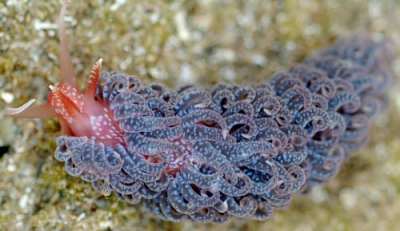
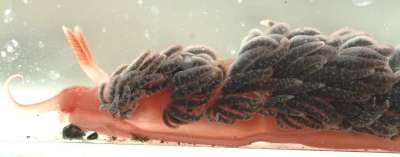
This beautiful nudibranch was found in a shallow rock pool on Long Reef Rock Platform. We were wondering which species it is and what it feeds on, and any other fascinating features that this particular type might have. It was photographed in a plastic specimen container and in a rock pool, so I have included a lateral and a dorsal view of it.
Locality: Long Reef Rock Platform, Fishermans Beach, Collaroy, less than 10 cm deep, New South Wales, Eastern Australia, Pacific Ocean, 24th February 2006, Intertidal, shallow rock pool. Length: 75 mm. Photographer: Donald Miles.
Thanks,
Don
auseco@optusnet.com.au
Miles, D.W., 2006 (Mar 16) Another Spurilla chromosoma from Sydney. [Message in] Sea Slug Forum. Australian Museum, Sydney. Available from http://www.seaslugforum.net/find/15975Dear Don,
As you will see from Maggie Mitchell's message [#15736] which I am also posting today, and a number of earlier messages [#15668; #15643], this is an interesting find. It is an animal we are identifying at present as Spurilla chromosoma, and has been reported at various places in the Pacific and Atlantic Oceans, suggesting it is a 'tramp' species able to travel about the world probably as a result of shipping. This is the 3rd record from Sydney in 2 months, and the 4th from New South Wales in the same period. Since it has not been reported from eastern Australia before, this suggests it is a recent arrival which is apparently flourishing.
As to what it eats. It is a member of a family of aeolids, the Aeolidiidae, which almost all feed on sea anemones. I suspect this one will do the same.
Best wishes,
Bill Rudman
Another Spurilla chromosoma from Sydney
March 16, 2006
From: Maggie Mitchell
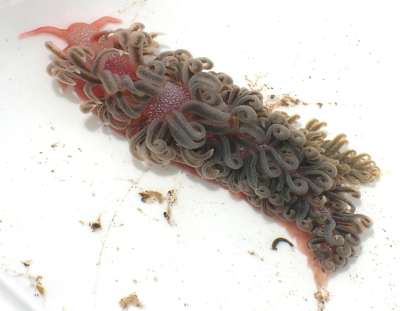
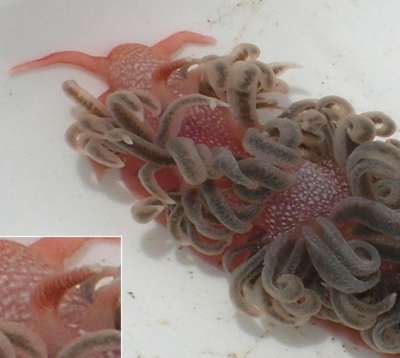
Dear Bill
Here is a sea slug found by Phil Coleman at Long Reef Aquatic Reserve in a rock pool at low tide, which I photographed for him.
Locality: Long Reef Aquatic Reserve, Dee Why, Northern Beaches, Sydney, NSW, Australia. Intertidal rock platform. Length: 10-15 cms. & January 2006. AM C452367. Photographer: Maggie Forbes-Mitchell
Maggie Forbes-Mitchell
maggiefm@hotmail.com
Mitchell, M, 2006 (Mar 16) Another Spurilla chromosoma from Sydney. [Message in] Sea Slug Forum. Australian Museum, Sydney. Available from http://www.seaslugforum.net/find/15736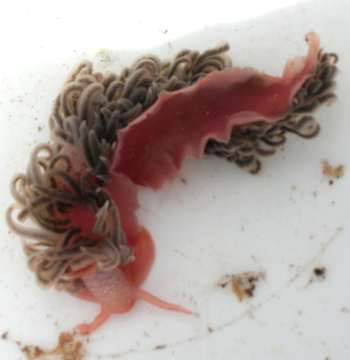
Dear Maggie,
This is an interesting find, as it is one of a number of sightings of this species from the Sydney region and other parts of New South Wales - all in the last 3 months. What makes it so interesting is that this is a species which has been identified as Spurilla chromosoma, formerly known only from the Californian coast of North America. I am not 100% convinced that it is the Californian species, but your species, whatever it turns out to be, has been recorded from Japan, Hong Kong and the west Atlantic, suggesting it is a 'tramp' species being distributed by shipping. These recent records from eastern Australia are the first of this species from this part of the world.
I am in the process of dissecting the larger of your two specimens to comfirm its identity and will post my results in the near future. Have a look at the other recent messages on this species attached to this page.
Best wishes,
Bill Rudman
Re: Spurilla chromosoma? from Bare Island, Sydney
January 31, 2006
From: Jason Hoare
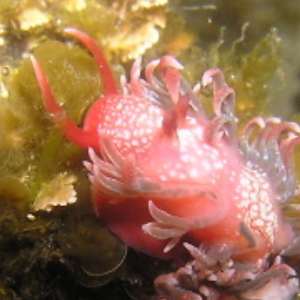
Concerning message #15690:
Hi again Bill. First - well said Paul. This is an excellent forum.
No luck finding that nudi again (5 of us spent 2.5 hrs eacj looking on Sunday). Elusive!
And unfortunately the other shots I have are pretty much just variations in angle. Nevertheless, here they are.
Locality: Bare Island, Botany Bay, Sydney, NSW Australia. Length: 30 mm. 23 January 2006. intertidal. Photographer: Jason Hoare
Best regards,
Jason.
jason21@internode.on.net
Hoare, J.L., 2006 (Jan 31) Re: Spurilla chromosoma? from Bare Island, Sydney. [Message in] Sea Slug Forum. Australian Museum, Sydney. Available from http://www.seaslugforum.net/find/15711Thanks Jason,
They are certainly not always the most obliging animals when you want to refind them. What I was interested in was the shape of the rhinophores, but unfortunately not quite enough magnification to see any detail.
Thanks for trying
Best wishes,
Bill Rudman
Re: Spurilla chromosoma? from Bare Island, Sydney
January 28, 2006
From: Jason Hoare
Concerning message #15683:
Hi Bill,
Some friends and I diving on Sunday specifically to look for this nudi again. I have a request from Richard Willan from the museum in NT for a specimen if possible. While we're at it (! and if we're lucky!) would one be useful for you too?
Regards,
Jason Hoare.
jason21@internode.on.net
Hoare JL, 2006 (Jan 28) Re: Spurilla chromosoma? from Bare Island, Sydney. [Message in] Sea Slug Forum. Australian Museum, Sydney. Available from http://www.seaslugforum.net/find/15690Dear Jason,
Nice to know Richard is reading the Forum. Seems little point in duplicating what Richard is doing. As I have said before, what really needs to be done is an examination of true Spurilla chromosoma from California so we can make valid comparisons with these other animals which are being identified with it.
Best wishes,
Bill Rudman
Re: Spurilla chromosoma? from Bare Island, Sydney
January 27, 2006
From: Jason Hoare
Concerning message #15643:
Dear Bill,
yes, that is the photo that I meant to send. Thanks for your identification, and interest. I think I still have some others on my computer. I'm not at home for a couple of days but will certaily get them to you when I return.
Best wishes,
Jason.
jason21@internode.on.net
Hoare, J.L., 2006 (Jan 27) Re: Spurilla chromosoma? from Bare Island, Sydney. [Message in] Sea Slug Forum. Australian Museum, Sydney. Available from http://www.seaslugforum.net/find/15683Dear Jason,
I look forward to some more photos. As Denis's message today shows [#15668], this species certainly seems to have somehow reached the east coast of Australia.
Best wishes,
Bill Rudman
Re: Spurilla chromosoma? from Bare Island, Sydney
January 27, 2006
From: Denis Riek
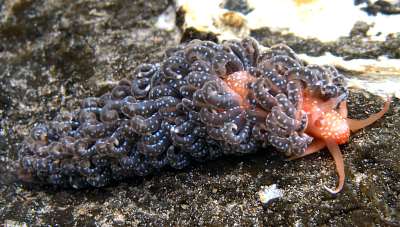
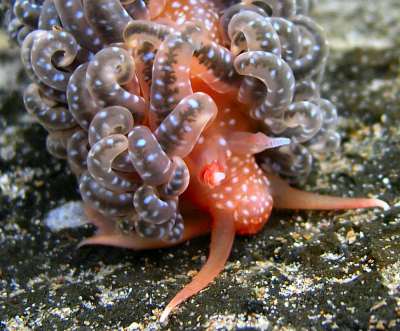
Concerning message #15643:
Dear Bill,
Here are some images of what I thought may be Spurilla chromosoma. It was found in very shallow water at high tide and curled up appeared more like an anemone than a slug.It looks like it has suffered damage to its rhinophores. This was a fairly large specimen (60 mm) and I have also found two smaller specimens which may also be the same species.
Locality: Brunswick River, nthn New South Wales Australia. Depth: 1 metre
Length: 60 mm. 01 May 2005. Rock wall in river. Photographer: Denis Riek
Regards
Denis
dwriek@optusnet.com.au
Riek, D.W., 2006 (Jan 27) Re: Spurilla chromosoma? from Bare Island, Sydney. [Message in] Sea Slug Forum. Australian Museum, Sydney. Available from http://www.seaslugforum.net/find/15668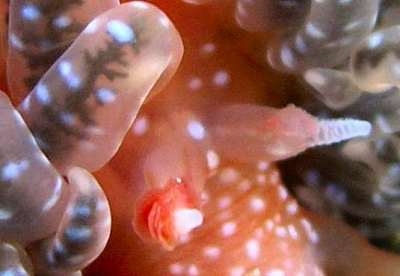
Dear Denis,
The shape of the body including the tentacular anterior foot corners and arrangement and shape of the cerata certainly fit the animal we are calling S. chromosoma, as does the colour. In particular, the colour and rhinophores shape fit animals from Japan which have been identified as Spurilla chromosoma. I am not convinced, without further anatomical work, that the two animals I have illustrated on the Fact Sheet are the same species. Whatever transpires about its true identity, your record and Jason's certainly shows that this species is present in eastern Australia and is almost certainly a new introduction to Australia.
Best wishes,
Bill Rudman
Spurilla chromosoma? from Bare Island, Sydney
January 26, 2006
From: Jason Hoare
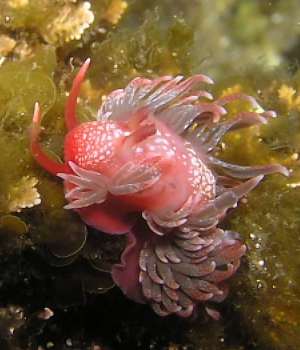
Hi there,
I've not seen this nudibranch before, and was wondering if you could tell me what it is. .
Locality: Bare Island, Botany Bay, Sydney, NSW, Australia.: Depth: 1 m. Length: 30 mm. 23 January 2006. intertidal. Photographer: Jason Hoare
Thanks,
Jason
jason21@internode.on.net
Hoare, J.L., 2006 (Jan 26) Spurilla chromosoma? from Bare Island, Sydney. [Message in] Sea Slug Forum. Australian Museum, Sydney. Available from http://www.seaslugforum.net/find/15643Dear Jason,
This is a very interesting find. Can you first confirm this is the photo you meant to send? Sometimes contributors load the wrong file when posting a message. Why I ask is that I suspect this is an animal more at home on the west coast of North America than in the South Pacific.
It looks almost identical to Spurilla chromosoma which was first reported from California and now is found around the Nth Pacific to Japan. There is a photo on the Forum [#6713] of an animal from Japan which is very similar to yours. There is also an animal from Hawaii [#1385] which has tentatively been identified with the Mediterranean Spurilla neapolitana, which looks very similar.
Whatever it is, it is not a common New South Wales species. Have you other photos of it? It would be particularly helpful to see more clearly the structures at its front end - head, tentacles, shape of anterior foot etc.
Best wishes,
Bill Rudman
Spurilla chromosoma from Ecuador
August 10, 2003
From: Soledad Luna
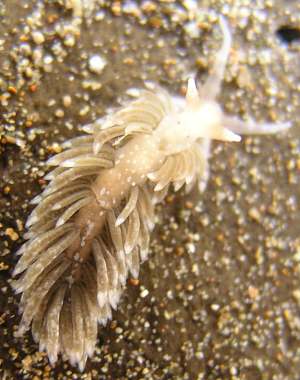
Hello,
Here is another seaslug from Los Frailes we collected on the coast of Ecuador [South America - east Pacific] in July 2003.
We would like you to help us identifying this specimen.
Thank you very much
Soledad Luna
soledadl@mail.usfq.edu.ec
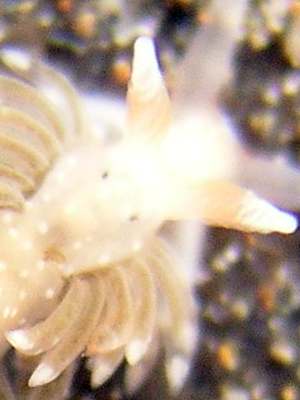
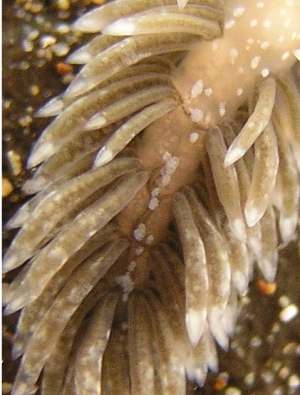
Dear Soledad,
I am pretty sure this is Spurilla chromosoma. If so, it has an interesting distribution from Ecuador right around the Pacific to Japan and southern China.
Best wishes
Bill Rudman
Re Mystery aeolid from California
October 22, 2002
From: Orso Angulo
Hi Bill,
Regarding the mysterious aeolid found in California by Sean Kearny, Its most likely that it is Aeolidiella chromosoma. It agres in the coloration of the rhinophores, number of lamellae and the very light spots in the ceras as well the form of them. This species has a quite large range in color variations, going from very light coloration (as the photo) through bright orange.
Hope it helps.
Orso Angulo
mol@cromwell.com.mx
Angulo, O., 2002 (Oct 22) Re Mystery aeolid from California. [Message in] Sea Slug Forum. Australian Museum, Sydney. Available from http://www.seaslugforum.net/find/8215Dear Orso,
Thanks very much for your suggestion. It would be interesting to see some photos of colour variation in California and Mexico as most of the photos on the Forum are from the NW Pacific - Japan, China
Best wishes,
Bill Rudman
Mystery aeolid from California
October 16, 2002
From: Sean Kearney
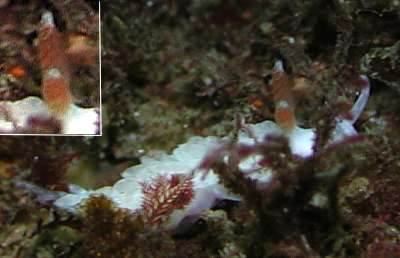
Bill:
Need help identifying this good looking nudibranch. Lamellate rhinophores, clear lanceolate cerata tipped with white, oral tentacles clear to opaque, cerata begin posterior to rhinophores. About 25mm at 75' Pt. Loma, San Diego, California.
Perhaps it is Aeolidiella oliviae? The cerata are a different color but otherwise quite similar.
Thanks again for your terrific site.
Sean
skearney@dc.rr.com
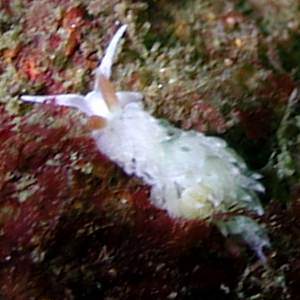
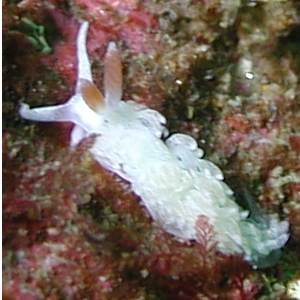
Dear Sean,
Aeolidiella oliviae does have orange lamellate rhinophores, but from my reading, the ceratal wall is bright orange. Perhaps its a juvenile? I am sure one of the many Californian contributors to the Forum can help us out
Best wishes,
Bill Rudman
Re: Spurilla neapolitana or S. chromosoma
April 18, 2002
From: Jun Imamoto
Dear Bill.
Thanks for your comments. This S. chromosoma was just beside the egg at the time of the discovery. Therefore, I think that it is most probably its egg ribbon. It seems that the season for S. chromosoma in Japan is finished, but they are very common, so I will observe them again next season. I'll then send you some more detailed photos of the eggs.
Best Regards,
Jun Imamoto
imamoto@wips.co.jp
Imamoto, J., 2002 (Apr 18) Re: Spurilla neapolitana or S. chromosoma. [Message in] Sea Slug Forum. Australian Museum, Sydney. Available from http://www.seaslugforum.net/find/6756Spurilla neapolitana or S. chromosoma
April 17, 2002
From: Jun Imamoto
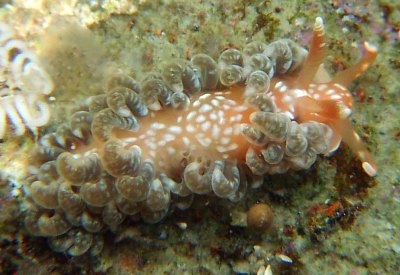
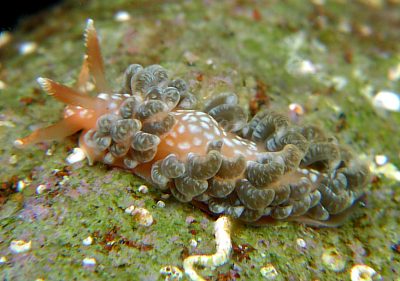
Dear Bill.
I don't know whether this sea slug is S. chromosoma or S. neapolitana. I have sent a photograph of its egg ribbon in a separate message
Date: Nov 2001
Place: Shimoda,Izu Peninsula(Sagami Bay),Japan
Depth: Intertidal (3cm)
Size: 20 - 25mm.
Best Regards,
Jun Imamoto
imamoto@wips.co.jp
Imamoto, J., 2002 (Apr 17) Spurilla neapolitana or S. chromosoma. [Message in] Sea Slug Forum. Australian Museum, Sydney. Available from http://www.seaslugforum.net/find/6713Thanks Jun,
I have discussed its identity in your other message.
Bill Rudman
Egg ribbon of S. chromosoma ? from Japan.
April 17, 2002
From: Jun Imamoto
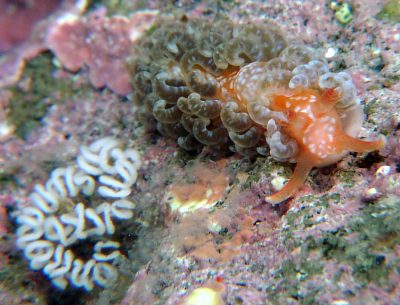
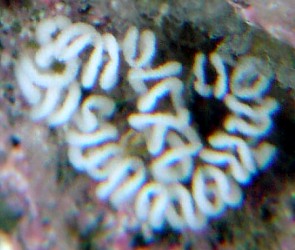
Dear Bill.
To accompany my other photos, here are photos of the egg ribbon of Spurilla neapolitana or S. chromosoma from Japan. It seems to be S. neapolitana when it is judged from the egg. Please give me advice.
Date: Nov 2001
Place: Shimoda, Izu Peninsula (Sagami Bay), Japan
Depth: Intertidal (3cm)
Size: 20 - 25mm
Best Regards,
Jun Imamoto
imamoto@wips.co.jp
Imamoto, J., 2002 (Apr 17) Egg ribbon of S. chromosoma ? from Japan.. [Message in] Sea Slug Forum. Australian Museum, Sydney. Available from http://www.seaslugforum.net/find/6715Dear Jun,
Thanks for these interesting photos. Certainly the egg ribbon looks more like Daniel Gieger's photo of Spurilla neapolitana than Bruce Wight's photo of S. chromosoma.
However S. neapolitana from the Mediterranean has branches of the digestive gland ramifying through the body wall, which when full of zooxanthellae, appear as a dark brown network in the skin. I have never seen photos of Japanese animals showing this network. I am not sure which animals identified on the Forum as either species are correctly identified - except for the few from the Mediterranean [S. neapolitana] and California [S. chromosoma].
Although your photos don't solve the problem, they certainly give us something to think about.
Best wishes,
Bill Rudman
Spurilla chromosoma from Japan
September 23, 2001
From: Bill Rudman
Just a brief note to say that Dr Hamatani has published a report of this species in Japan identifying this species as Spurilla neapolitana. I guess the identity of the animal identified in the Forum from Japan and Hong Kong as Spurilla chromosoma will only be resolved when the anatomy of animals of S. chromosoma from California and S. neapolitana from the Mediterranean are re-examined. From recent messages from Colombia, it would also help if specimens from the Caribbean are looked at as well.
• Hamatani, I (2000) A new recorded species of the genus Spurilla Bergh, 1864 from Osaka Bay, Middle Japan (Opisthobranchia, Aeolidacea). Venus, The Japanese Journal of Malacology, 59(3): 263-265.
Bill Rudman
Rudman, W.B., 2001 (Sep 23) Spurilla chromosoma from Japan. [Message in] Sea Slug Forum. Australian Museum, Sydney. Available from http://www.seaslugforum.net/find/5312Spurilla chromosoma from Hong Kong
July 22, 2001
From: Leslie Chan
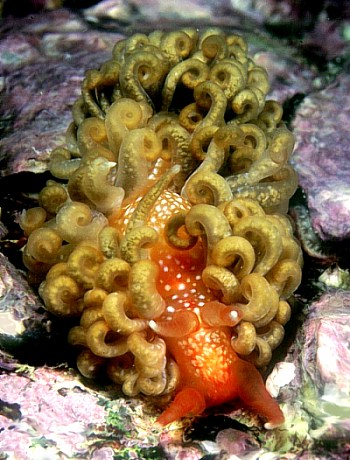
Dear Bill,
Could you identify this nudibranch which I photographed in Hong Kong.
Details: 10m, Trio Island, Hong Kong. 25 December 2000.
Thanks
Leslie Chan
leslie@lesmart.com
Chan, L., 2001 (Jul 22) Spurilla chromosoma from Hong Kong. [Message in] Sea Slug Forum. Australian Museum, Sydney. Available from http://www.seaslugforum.net/find/4774Dear Leslie,
This is Spurilla chromosoma. It was originally described from the west coast of North America but has been reported from Japan [see Yoshi Hirano's message below]. I am pretty sure this is the first record from Hong Kong.
Best wishes,
Bill Rudman
Spurilla chromosoma from California
February 7, 2001
From: Bruce Wight


Hi Doc,
Here is another aeolid from southern California. It is known as Aeolidiella chromosoma. These two animals were found under a rock at San Clemente island. I have also sent a photo of its egg ribbon.
Take care,
Bruce Wight
bwproductions@earthlink.net
Wight, B., 2001 (Feb 7) Spurilla chromosoma from California. [Message in] Sea Slug Forum. Australian Museum, Sydney. Available from http://www.seaslugforum.net/find/3696Thanks Bruce,
I have placed this species in the genus Spurilla, where it was first described, rather than Aeolidiella. Althought the radula is superficially similar to that of some species of Aeoldiella it is not that different from that of some species of Spurilla. I think there is still much work to be done on the relationships within the aeolids. Until the situation is clearer I will leave this species in Spurilla so there is some internal conssistency in the Forum.
Bill Rudman
Spurilla chromosoma egg mass
February 7, 2001
From: Bruce Wight

Here is a photo of the egg ribbon of Spurilla chromosoma to accompany my earlier photos. It was photographed at San Clemente island, southern California.
Bruce Wight
bwproductions@earthlink.net
Wight, B., 2001 (Feb 7) Spurilla chromosoma egg mass. [Message in] Sea Slug Forum. Australian Museum, Sydney. Available from http://www.seaslugforum.net/find/3697Spurilla chromosoma not S. neapolitana from Japan
March 19, 2000
From: Y. Hirano

Dear Bill,
I had a look at the recent messages about an aeolid nudibranch from Japan which could be Spurilla neapolitana.
I think I have often collected specimens of this species and I am quite sure it is Aeolidiella chromosoma (Cockerell & Eliot, 1905). I dissected the specimens and found good morphological characters with which I can identify them as the species.
I reported this at the annual conference of the Japanese malacological Society held a year ago, as one species of species list newly found from Japan. I do not know whether the species was introduced to Japan from the east Pacific coast, or whether it was originally native to Japan. Anyway there is not yet any information on the species on the illustrated books or papers so far published in Japan.
The body colour is quite variable depending on specimens from vermilion, dull orange to thin cream yellow. They are usually found from underside of large boulders in the intertidal zone. It does not seem to be uncommon in Japan. I have attached a photo for the forum.
Data: October 28, 1996. Intertidal of Kominato coast, Boso Peninsula, Japan. Body length 25 mm. Rhinophores lamellate. PHOTO: Yoshi J. Hirano.
Very best wishes,
Yoshi
hiranoyj@earth2.s.chiba-u.ac.jp
Hirano, Y., 2000 (Mar 19) Spurilla chromosoma not S. neapolitana from Japan. [Message in] Sea Slug Forum. Australian Museum, Sydney. Available from http://www.seaslugforum.net/find/2121Dear Yoshi,
Thank you very much for the photo and the information. I have had a look at the published descriptions of S. neapolitana and S. chromosoma and can't see too many differences other than Ernst Marcus (1961) saying that the anterior ceratal cluster on each side in S. chromosoma consisted of about 4 rows as compared with the single rowed arch in S. neapolitana. It would be interesting to have some input from anyone familiar with S. chromosoma in its 'home territory'.
Best wishes,
Bill Rudman.
Re: Re: Spurilla neapolitana? from Japan
March 17, 2000
From: Satoru Hori
Dear Bill,
Thank you for your identification.
It is surprising for me that you commented "if it were Spurilla neapolitana it would be an interesting new record."
Last year I found three or four "Spurilla neapolitana?" on the same beach. This year I am going to go that beach again. Recently I bought macro lens for my camera, so I will be able to send you photos in which you can see the shape of the rhinophores if I find "Spurilla neapolitana?" again.
Best regards,
Satoru Hori.
ik8s-hr@asahi-net.or.jp
Hori, S., 2000 (Mar 17) Re: Re: Spurilla neapolitana? from Japan. [Message in] Sea Slug Forum. Australian Museum, Sydney. Available from http://www.seaslugforum.net/find/2105Dear Satoru,
If your animal is a recent introduction to Japan, perhaps from some larvae in ballast water, or from adults on the outside of a ship, then it is fairly usual for there to be an initial population explosion. Is the place where you are finding these animals near a major port with overseas shipping?
Sometimes introductions don't survive past the initial generation, other times they do very well and become pests in their new home.
Good luck with finding and photographing another animal.
Best wishes,
Bill Rudman.
Re: Spurilla neapolitana? from Japan
March 16, 2000
From: Satoru Hori
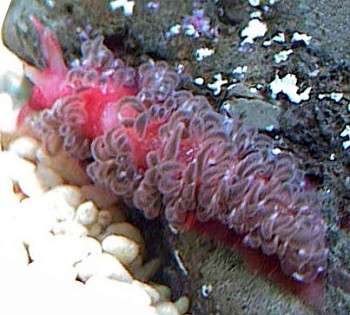
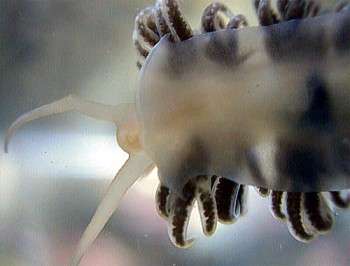
Dear Bill,
Thanks for your prompt reply.
I attach another two photos by my friend Yutaka Yamada.
The animal in the first photo is red because he ate a red sea anemone. The rhinophores in this picture are the most clear one in the photos that I have. I think it is difficult for you to see the shape of the rhinophores.
You can see oral tentacles clearly in the second photos but no rhinophores.
Could you get any information this photos?
Best regards,
Satoru Hori.
ik8s-hr@asahi-net.or.jp
Hori, S., 2000 (Mar 16) Re: Spurilla neapolitana? from Japan. [Message in] Sea Slug Forum. Australian Museum, Sydney. Available from http://www.seaslugforum.net/find/2097Dear Satoru,
I must say your photos, especially the red one make me think this is Spurilla neapolitana. I may be guessing but the rhinophores in the upper photo don't look smooth to me and could quite easily have ridges.
I am afraid the only way to be sure would be to find another specimen so we could look at its anatomy or at least check the shape of the rhinophores.
It doesn't look like any other species of the Aeolidiidae reported from Japan so if it were Spurilla neapolitana it would be an interesting new record. I would appreciate some comments from anyone familiar with true Spurilla neapolitana.
Best wishes,
Bill Rudman.
Spurilla? from Japan
March 14, 2000
From: Satoru Hori
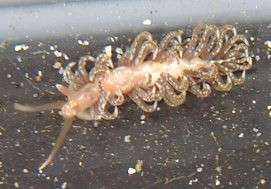
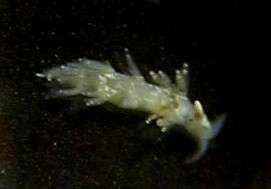
Dear Bill,
I attached 2 image files.
I think they are Aeolidiella indica.
But I have no confidence. Would you identify them for me?
They were found under a stone in a tidepool in Miura Peninsula, Japan.
Length of white one is 5mm and that of light brown one is 20mm. Light brown one eats sea anemones.
Best regards,
Satoru Hori.
ik8s-hr@asahi-net.or.jp
Hori, S., 2000 (Mar 14) Spurilla? from Japan. [Message in] Sea Slug Forum. Australian Museum, Sydney. Available from http://www.seaslugforum.net/find/2085Dear Satoru,
Eating sea anemones definitely suggests that your animal is a member of the family Aeolidiidae. However from its shape I am pretty sure that it is not Aeolidiella indica.
It looks very like a species of Spurilla and almost identical to Constantine Mifsud's photo of Spurilla neapolitana from the Mediterranean. S. neapolitana has also been recorded from Hawaii and the East Pacific so it is probable that it is been spread artificially. Unfortunately I can't see the shape of the rhinophores in your photos. If you could scan a closeup of the head region for me I could check whether the rhinophores are smooth, lamellate or papillate.
Best wishes,
Bill Rudman.
